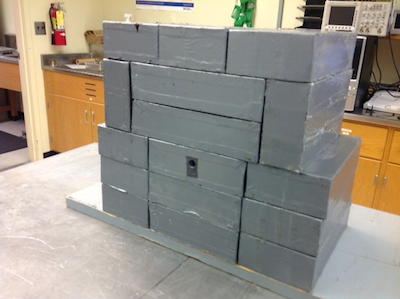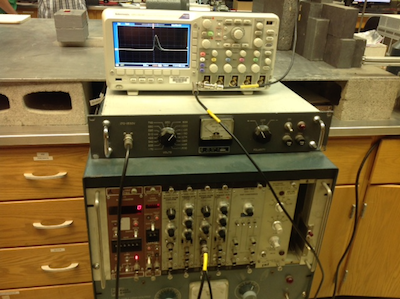Compton Scattering
This experiment allows one to verify the energy shift of inelastically-scattered gamma rays. It is regarded as one of the "classic" experiments in modern physics. It is important to modern physics because it demonstrates that light cannot be explaned purely as a wave phenomenon: electromagnetic scattering cannot explain the shift in wavelength that is observed.
This experiment was first done by Arthur Compton in 1923, and he won the Nobel prize for it in 1927. Our particular apparatus has been working for almost as long, and is generally reliable.
 |
 |
 |
Reading
- Review the section on Compton effect (or Compton scattering) in your modern physics textbook. I.e. section 3-4 of Tipler or section 3.4 of Harris.
- Arthur H. Compton. "The spectrum of scattered x-rays" The Physical Review, 22(5):409-413, Nov 1923. (A copy of this paper is on file in room 108.)
- Here is an experiment manual from a different class that describes the experiment. Note that for this particular class the calibration was performed by the instructor ahead of time, which will not be the case for your experiment!
- Instructions for building the beam collimator "house"
Questions
- What is a Multi-Channel Analyzer? Why are you using one here?
- Explain how you will calibrate your MCA.
- Why are we using Aluminum as a scattering target?
- Explain how the NaI detector and PMT work.
Location
Room 107.
Equipment needed
- Spectech Multi-Channel Analyzer
- Oscilloscope (Optional, but very useful!)
- High-voltage supply for Photomultiplier tube
- NaI/PMT detector in movable "pig" on goniometer
- Ortec 435A NIM amplifier
- HOT cesium-137 source in lead collimation "house"
- Small exempt "button" gamma sources for calibration
- Dosimetry badge
Cautions
- The detector and NIM bin must warm up at least a half-hour before you can expect to get consistent results.
- The cesium 137 source used in this lab is the one radioactive source in Advanced Lab that actually makes me nervous. Treat it with great respect and with minimal contact. Actually, just leave it in the house and don't open the beam-block lead brick unless you need the beam for a measurement.
- One lab partner must wear a dosimentry badge in the lab at all times while this experiment is in use.
- There are high voltages present on the PMT. Make sure all cables are connected before turning things on. The HV should be the last thing you turn on, and the first thing you turn off.